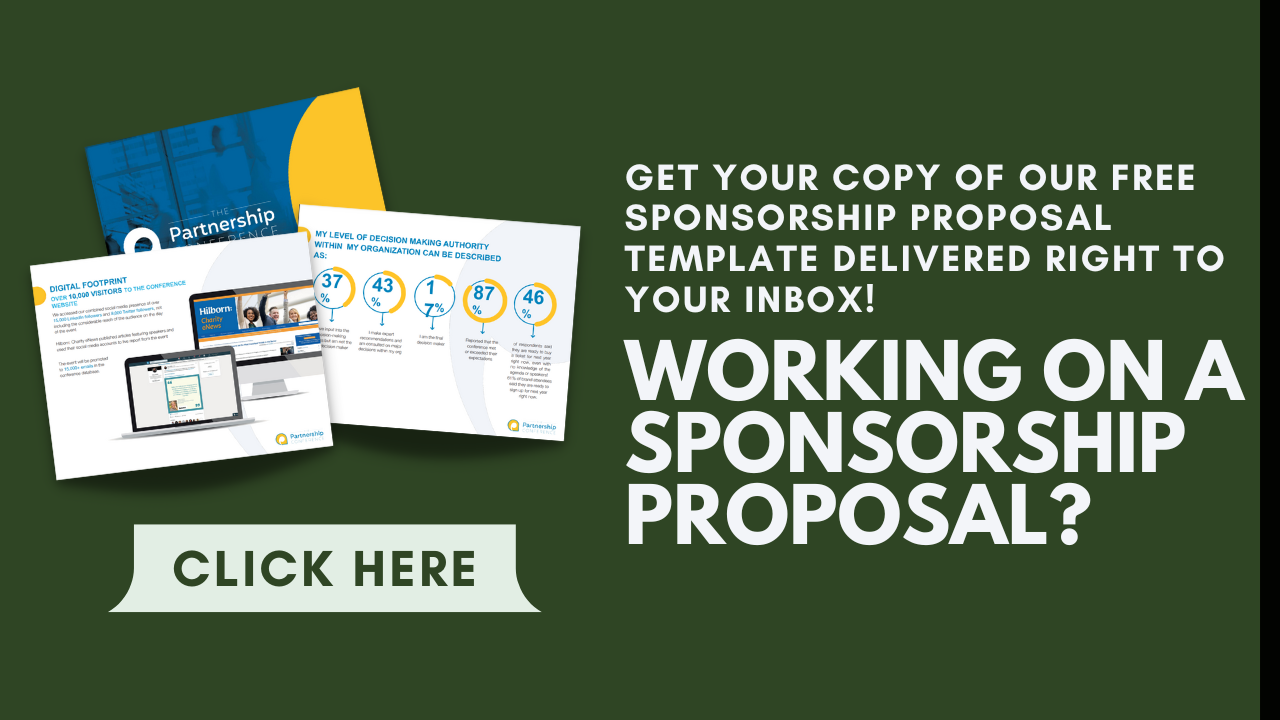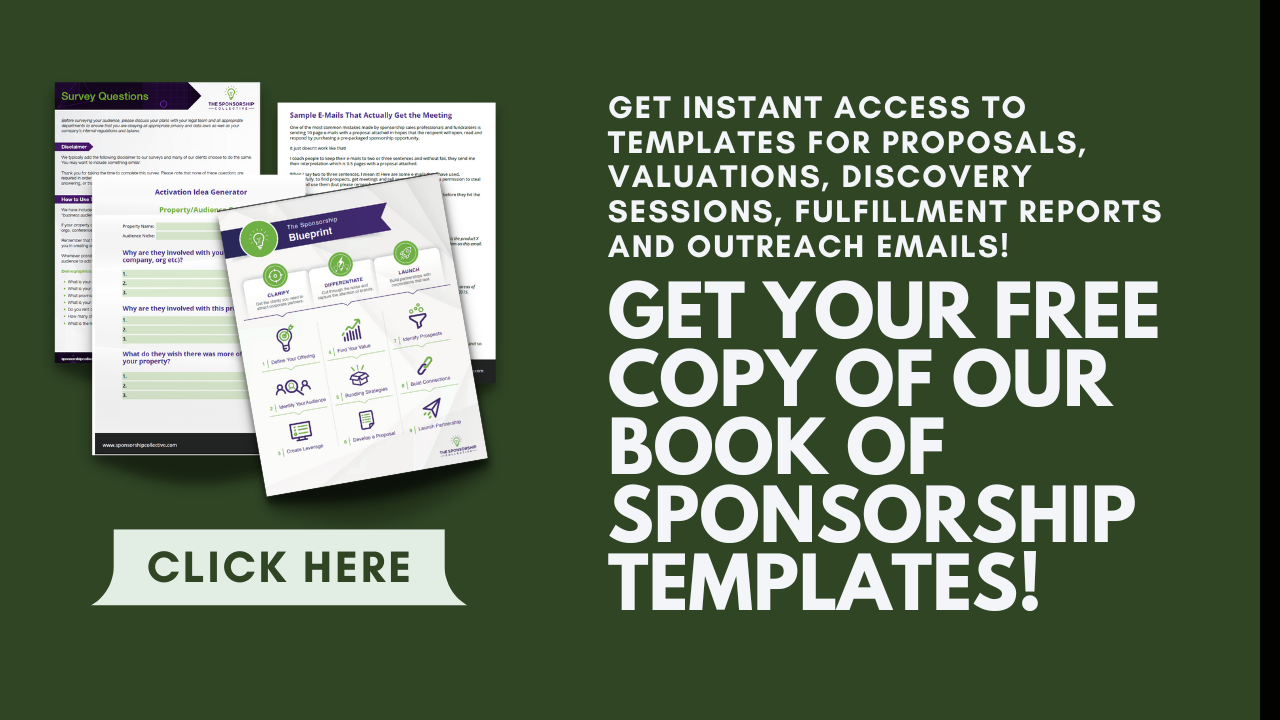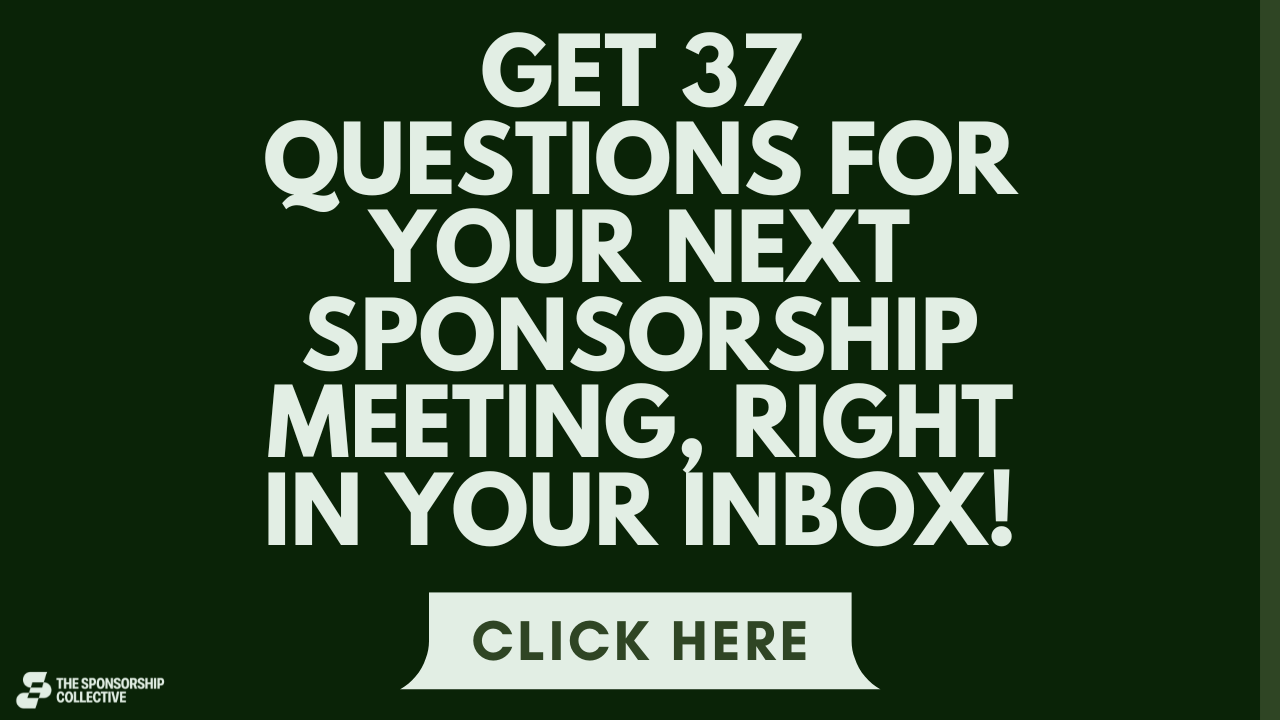In business, if you want to determine how successful anything you do is, you track the return on investment or ROI.
For instance, if you spend $1,500 on a billboard for 30 days and the billboard nets you 500 new leads who end up earning your company $3,000, then your ROI was $1,500.
It’s easy to quantify your ROI in business, but in sponsorship programs, a lot of my clients struggle.
Perhaps you’re also in a similar situation yourself, which is why you’re reading this post.
I understand where you’re coming from, and I want you to be able to measure sponsorship ROI so you can begin making more sound decisions in the future. In today’s post, I’ll tell you exactly how it’s done.
Let’s dive right in.
How You Shouldn’t Measure Sponsorship ROI
Okay, so here’s the million-dollar question. As a sponsorship seeker, how do you measure ROI for your sponsorship program?
Well, before I get into that, I want to talk about how not to measure sponsorship ROI.
I know, this may seem like a strange angle to take this article, but it’s so you can see which missteps you already might be making and can avoid them for the future.
A lot of sponsorship seekers assume that you have to prove how your sponsorship engagement created sales or other measurable outcomes for the sponsor. Except, determining the extent of those outcomes without the sponsor’s data in front of you is really hard.
Now, if your sponsor wants to provide you with this data, that’s another thing entirely (and the ideal situation), as otherwise, you’re just shooting in the dark.
Here’s another situation in a similar vein. Let’s say you generated 1,000 leads for your sponsor.
Whether it’s because the sponsor didn’t have a good opt-in form or lead magnet or their website wasn’t optimized enough, they only converted 506 of those customers.
Should that be a measure of failure on your part even though you lived up to your end of the deal?
In both these situations, the outcomes are out of your control. You can’t help what your sponsor does with those leads when they have them. If the sponsor squanders their opportunity, be it for one of the reasons outlined above or something else entirely, that doesn’t mean you failed.
How You Should Measure Sponsorship ROI
A sponsorship is a two-way partnership. Even though you and another company will come together, at the end of the day, you can’t control what your sponsor does any more than they can control what you do.
If you focus on what you cannot control when measuring sponsor ROI, then you’ll feel like you have no idea what to start or what to measure, as I hope I made clear in the last section.
I instead recommend focusing on what you can control, such as the following metrics.
Logo Placements
I know, I always talk down on logo placement, but I’ve never said that logos don’t play a role in your sponsorship program. They just have a very small role because they’re not the most valuable asset you can offer.
But I’m sure you already know that, so let’s move on.
If you promise your sponsor 10 logos throughout the event space or conference hall, that’s very easily measured. You can walk through the space, photograph each logo, and then label them 1 through 10.
Your sponsor cannot refute that you provided 10 logos. More crucially, the logo placement–while still benefiting the sponsor–is not something the sponsor controls, so it’s easy to measure.
As for what kind of engagement or brand awareness a logo can drive, that’s impossible to determine.
Speaking Engagements
Did you promise your sponsor a speaking engagement? What kind of engagement? Maybe it was the opening statement or a primetime hour-long speaking slot?
Perhaps you told the sponsor that if they spoke, 500 people would be there to listen.
Just as you did with logo placement, you can prove to the sponsor that they got the prescribed time slot for their speaking arrangement as well as the amount of time you promised.
You can also use apps, ticketing software, and other handy tools for determining how many people attended the sponsor’s speaking engagement.
If the speaking engagement led to more leads or customers for the sponsor afterward is harder to say, but through the technology trail, it might not be impossible to determine.
Attendance Numbers
Speaking of attendance, this is another means of measuring sponsorship ROI that’s completely in your hands (unless you split the ticket-selling duties with the sponsor, but that’s a rather unconventional arrangement).
As mentioned in the paragraphs above, you can use ticketing software, apps, or other tech to determine how many people bought tickets versus those who actually showed up.
Measuring data like this tells your sponsor that you can back up your claims. If you told them that 5,000 people would show up but only 2,000 do, that doesn’t look good for you.
When all 5,000 people are there, that means more people are in the building to engage with the sponsor’s activation and possibly convert.
Emails Sent
If your sponsor is interested in building awareness, which you’ll learn during the discovery session, then you might propose that you send an e-blast to your audience where you promote your partnership with the sponsor.
This is another one of those metrics in which proving your ROI is exceedingly simple. You can produce a list of email recipients (blocking identifying parts of their email addresses if you’re concerned about privacy) and show it to the sponsor.
If you said you’d email 500 contacts and there are 500 email addresses in the list, then that shows that you’ve lived up to your end of the deal.
Social Media Posts Made
In the same vein is the number of social media posts you made, again as a means of building awareness for your sponsor.
Now, I do want to add the caveat that just because I’m including these asset examples doesn’t mean these are assets that you yourself will offer to your sponsor. Just keep that in mind.
So, getting back to a social media deal to raise awareness for the sponsor company, you’d make X social media posts across Y platforms, maybe even for Z number of weeks or months.
This is something that you can easily prove and add to your ROI calculations as well.
Activations
Finally, tracking your activations is another great means of measuring sponsorship ROI.
In this case, you don’t solely want to prove that your sponsor’s activation existed in your event space.
You should detail what the activation is and what its goals are. If you can get the data from the sponsor, then you can determine how successful the activation was.
You’ll recall that activations are supposed to fulfill the needs of your audience as well as the needs of your sponsor in tandem.
Let’s use a really simple example and say that your audience needs caffeine, and your sponsor is a coffee company. The activation here is easy as pie; the sponsor provides a small coffee bar for attendees to fuel up.
Now, as for how many people showed up to the coffee bar, how many people took free samples, how many people signed up to the sponsor’s email list, and how many of them opened follow-up emails, you cannot say without sponsor data.
You’re not the sponsor. You didn’t watch their booth nor are you in their email system tracking emails sent and received.
You can maybe link the booth to an app to gauge interest or attendance that way, but even then, that’s mostly out of your control.
What Is Success? The Importance of Having a Conversation with Your Sponsor Ahead of Your Program, Event, or Opportunity
Going back to the point I made from before, the above assortment of assets ran the gamut. Thus, your sponsor probably won’t want every single asset listed. Which ones they’re most interested in will depend on their goals.
One of the most critical errors you can make is assuming you know what your sponsor wants and putting together a list of assets that has nothing to do with them. Instead, it’s all based on assets you think they’d like.
Imagine meeting someone, talking to them for an hour, and then being tasked with buying a birthday present for them. You would have no idea what to get because you don’t really know this person, so you’re forced to guess.
You might guess they like Star Wars because of one off-handed reference, or perhaps you assume because they’re a guy that they’re into sports or that they’re a girl so they like makeup or perfume.
You wouldn’t feel very confident giving someone a gift you bought without really knowing them, right?
Just as you shouldn’t be confident that you’re giving your sponsors what they really need unless you two sit down for a discovery session.
Yes, there’s that term again, discovery session.
If you need the recap, a discovery session is a meeting between you and your prospect where you discuss their current challenges, shortcomings, and goals.
During the discovery session, it’s a good idea to ask some questions to get a clear definition of how your sponsorship prospect defines success.
For example, if your prospect is looking to raise its brand awareness, how many impressions would be meaningful to the company?
If they’re more interested in lead gen, how many leads would be impactful enough? Or how many sales if the company’s sales have been sagging?
You need clear answers to these questions early on in the sponsorship process. This way, by the time you sit down to collect assets to offer the sponsor, you can be sure that the ones you selected solve the sponsor’s problems and produce success as the sponsor defines it.
Putting It All Together in Your Sponsorship Fulfillment Report
Your event has ended, and you fulfilled your parts of the deal just as the sponsor did theirs.
Remember, it’s not like you two just shook on the deal. You sat down with lawyers (at least, I hope you did) and negotiated a contractual agreement. That agreement, need I remind you, is legally binding.
That’s why you must cover your bases as your event, program, or opportunity wraps up, and there’s no better way to do that than with a sponsorship fulfillment report.
The fulfillment report goes through every asset and activation that you listed as part of your sponsorship program. You’d calculate the original value of the asset or activation based on your valuation.
Then, in a separate tab or column, you’d gauge what the new value of the asset or activation is based on how it performed (if its value changed at all).
You’d also detail how well the asset or activation did, whether it performed exactly as expected, overperformed, or underperformed.
Your goal as a sponsorship seeker is always to exceed expectations. At the very least, you want to meet expectations, but the more you can exceed them, the better.
Since sponsorship is indeed a two-way partnership, recognize that not every asset or activation was completely within your control. Failure then might not always be something that hinged on you.
Nevertheless, you can’t shy away from the areas where you underperformed. Be honest, explain yourself, and don’t hide the mistakes under the rug.
A sponsorship fulfillment report gives you a perfect excuse to sit down and meet with your prospect again.
Knowing what you do about their definition of success, you should have a pretty good idea based on your fulfillment report of whether the sponsorship arrangement was successful or not.
If it was and you wish to work with this sponsor again in the future, the fulfillment report also makes for a great conversation starter about renegotiating a deal.
Conclusion
A lot of sponsors come to me clueless about measuring sponsorship ROI. That’s usually because they’re trying too much to focus on the factors that are in the sponsor’s control rather than those that are in their own control.
Now that you know what to focus on, you should find that measuring ROI is a lot easier!
- About the Author
- Latest Posts
Chris Baylis is the Founder and Editor-in-Chief of The Sponsorship Collective.
After spending several years in the field as a sponsorship professional and consultant, Chris now spends his time working with clients to help them understand their audiences, build activations that sponsors want, apply market values to their assets and build strategies that drive sales.
Read More about Chris Baylis




